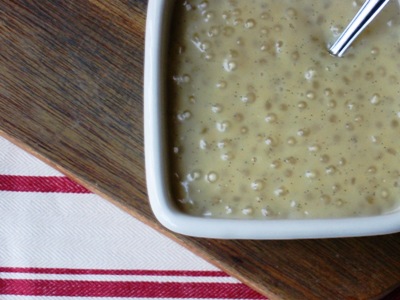Sunday, February 10, 2008
tapioca pudding
I like to think that I sort of "inherited" my love of cooking from my grandmother on my mom's side, but that's more of a sentimental thought than anything else. In truth, my love of cooking is something I developed almost entirely on my own. I have a few fond cooking memories sprinkled here and there in my brain -- making sugar cookies one Christmas with Grandma and learning the difference between a liquid and a dry measure from Mom -- but after those, my pursuit of new culinary knowledge and experiences became a completely independent endeavor. And although cooking is very much an independent hobby for me, I've never been interested in reinventing the wheel. I would much rather spend time reading about other people's culinary experiences -- successes and disasters alike -- and then incorporating what I learn into what I'm making in my own kitchen.
If I'm going to be completely honest, I'd have to say that prior to reading Heidi's post, I don't think I had any idea what tapioca was or how it was transformed into pudding. In fact, if you had asked me (and thank goodness no one did) I probably would have said that tapioca was a variety of rice. I would highly recommend reading Heidi's comments about making tapioca pudding before starting the recipe below. After making it myself, I can concur with her statement about using products containing soy lecithin: while it doesn't take away from the flavor, it does, indeed, make the pudding gelatinous. I used soy milk because that's what I had on hand, and though the flavor was great, the pudding was jiggly. I'll definitely make the pudding again and maybe try it out with coconut milk or caramel extract. I think it might also make an interesting cupcake filling....
[For those of you who, like me, sometimes find yourself floating in a dingy on the roaring sea of the culinary unknown, here is what the Bob's Red Mill package says about tapioca: Grown in the tropics, the cassava or tapioca plant produces a fleshy, edible root stock. A nutritious starch is then extracted from cassava and formed into "pearls."]
Tapioca Pudding
A recipe from Heidi Swanson at 101 Cookbooks
Serves 4 to 6
3 cups organic milk
1/3 cup small pearl tapioca
2 extra-large egg yolks, lightly beaten
1/4 teaspoon fine-grain sea salt
1/3 cup sugar
1 vanilla bean, split along the length (or 1 teaspoon vanilla extract or 1 tablespoon of vanilla bean paste)
Pour 3/4 cup of the milk into a medium-sized, thick-bottomed pot. Add the tapioca and soak for 60 minutes. Whisk in the egg yolks, salt, sugar, and the remaining milk. Scrape the vanilla bean along its length with a knife and add that bean "paste" along with the bean itself to the pot. (You can add prepared vanilla bean paste now as well, but if you are using vanilla extract, stir it in at the very end after the pudding has completely cooked.)
Over medium heat, slowly bring the mixture just barely to a boil, stirring all along -- this should take about 15 minutes. Reduce the heat and let the mixture fall to a simmer. Keep it here until the tapioca is fully cooked, another 20 minutes or so. Keep in mind this time can be significantly longer (or shorter). The tapioca will tell you when it is ready if you watch carefully. The tapioca beads will swell up and become almost entirely translucent. The custardy part of pudding will thicken dramatically as well. It is even more critical to keep stirring at this point avoid dreaded scorching. Remove from heat and let cool a bit. This tapioca tastes its best when served warm, but is delicious cold as well.
Subscribe to:
Post Comments (Atom)


man, I love tapioca pudding. all that creamy goodness with a smattering of smooth little round pearls...mmmm
ReplyDelete